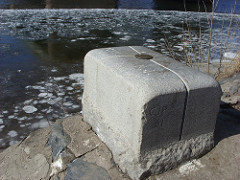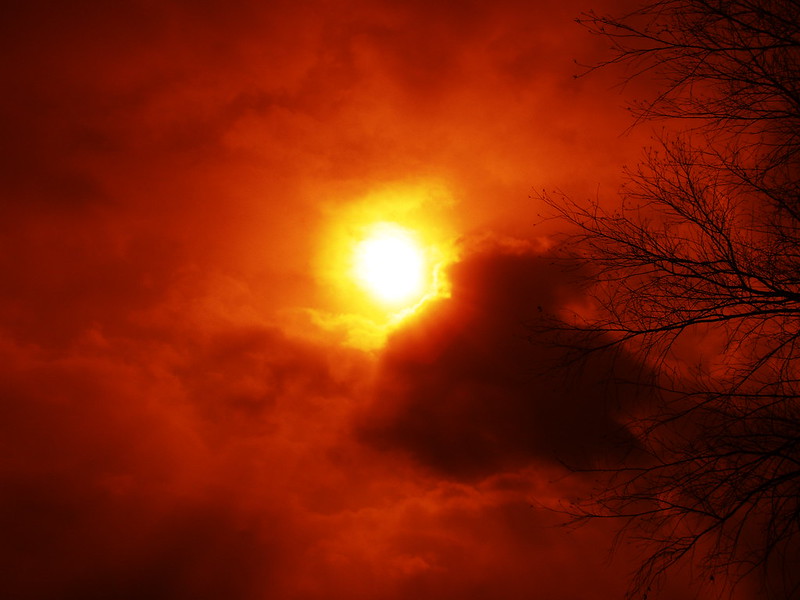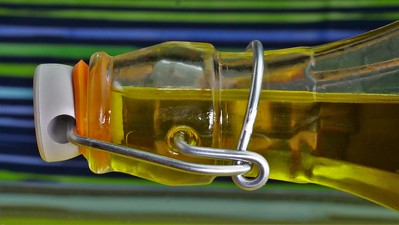Seen on a topographic map, the town of Port Jervis, New York, appears to be guaranteed some drama. It is situated at the point where New York, New Jersey, and Pennsylvania come together at the banks of the Delaware River, where the riverbed takes a radical turn to the southwest (as if it had suddenly decided to avoid New Jersey), deepens to eighty feet, and begins to take on the grandeur that will come to it fully in the Water Gap some ten miles farther south. But whatever Port Jervis once was—a railroad and logging hub, a transport center for the produce from local farms—it no longer is. The town center seems exhausted and weakened to such a point that no expectation or promise could safely settle on it again.
Across the river from Port Jervis, and connected to it by a bridge, is the town of Matamoras, Pennsylvania. It has the same dramatic geographic possibilities as Port Jervis and, by all the rights of its name—which loosely translates from the Spanish as “swashbuckling” or “arrogant”—should be a bustling, even elegant river town. It’s not. Rather, it is as ordinary, and in much the same way, as any other ordinary Eastern American town in the first years of the twenty-first century: its particularity diminished by bland suburban architecture and a main street mostly emptied of commerce and company.
My husband, Barry, spent some of his childhood summers at an aunt’s home near these two river-edging cities—they’d go to Port Jervis to shop, and there was a movie theater in Matamoras—but he hadn’t been back for nearly forty years when, one late summer afternoon, he and I drove into Port Jervis. We drove the length of the main street to the short tunnel that leads to the bridge across the Delaware, and then up and down the streets of Matamoras, looking for something that might compel us to look closer. But we were simply in motion. Until: we found ourselves at the abrupt edge of an open field in which, among other things and creatures, was an elephant.
Trailers and trucks sat in a tight line in the field, waiting to pull onto the road. There were a few people milling around outside the cab of an eighteen-wheeler that had a large, colorful circus logo on the side. The cabs of smaller trucks, RVs, and vans were full of men and women and children. The sky above them was wide open but overcast and low. Off to the side of the field, separated from the phalanx of vehicles, was a smaller tableau: a truck, a man in a folding lawn chair reading a newspaper, a dog lying on the ground, the elephant tethered by one foot to a post hammered into the earth. At the other end of the field were two towers of rusted metal topped with huge, badly deteriorated spotlights, each one pointed at a different angle into the sky.
Processed by memory, the clouds over the field in Matamoras are a near ceiling of slate gray, and they seem to keep what light was left in the day low to the ground, as if compressed into a flawless glass in which details vibrate with clarity, and with the possibility of meaning below and beyond their surfaces. I remember that the faces of the people in the cabs of the circus trucks and vans looked both tired and patient. That the man in the lawn chair (metal frame, green and white woven plastic seat and back) was reading a tabloid newspaper and turning the pages with the kind of slow regularity that meant he was glancing only at headlines and photographs. That the dog appeared to be sleeping, his body flat on the ground, his jaw resting on the brace of his paws. That the elephant’s ears revealed it to be Indian and moved forward and back every so often, like wings in slow motion. That the elephant leaned slightly away from the truck toward the man. That its tail switched sporadically. That the truck seemed too large for the man and his dog but not nearly large enough for the elephant. That the two hulking metal towers looked like large insects or pieces of scenery from a post-apocalyptic movie, archeological mysteries in the making. That when I realized they were light towers, the realization seemed literally to illuminate what I’d missed: the tarmac we’d just driven across, the dark double to the green field, had once been an airfield; the unconnected, faded swaths of white paint on the tarmac actually connected to form the word CLOSED.
***
I try to imagine—because he can’t remember the scene himself—Barry at eight or nine, squashed into the broad backseat of a 1950s car with three or four of his similarly aged cousins. Just two adults in the spacious front seat, their backs solidly turned on the boisterousness behind them. Driving from Port Jervis to Matamoras, they approach the bridge through the short tunnel. For an instant, there is almost complete darkness in and around the vehicle and then, just as quickly, a burst of light reflecting off river water and steel. That quick progression out of and into light might have caused a sensation of excitement in Barry, which, I go on imagining, was instilled in an even younger version of him when the darkness of the tunnel seemed more absolute, more lingering, and the burst of light a deliverance. The dazzle a young child is susceptible to stays with him as he becomes the older child who’s long forgotten its origins; who sees the road disappearing into the approaching tunnel and senses, though he doesn’t know why, that the curve of the pavement is moving him back toward something he feels now more than he remembers.
***
“Elephant/Airfield” is how I think of that Matamoras late afternoon, as if the image were preserved outside of me and I could use it in a piece of fiction. Need a bit of Felliniesque surprise? A moment of incongruity? An unexpected calm to counterbalance inner turmoil? Here it is, filed under E. But this image won’t be had so easily. Apparently, as it moved from my perception to its short-term perch in my memory to its long-term repository, it gained in obstinacy. The sky hunkered down into a tighter ceiling.
I have tried, but I cannot make this image function as fiction. I cannot lessen the specific weight of its obvious symbolism for even one instant. The CLOSED is unyielding; it casts a far-reaching shadow: Field closed. Circus closed. Day closed. Time closed. Era closed. Past closed. The line of circus vehicles will speak of nothing but transience, the fabled lure of the midway. And the elephant will not be disturbed in its melancholy. It is out of place, shackled to its small life; it can do nothing but stare, switch, flap, consider in its way, lean as if it desires something in another direction.
The light in that low-slung sky is a particularizing light: I see that the image is about nothing but itself, all its surfaces intact, powerful, banal, and unassailable.
I return to the details of the car ride in Matamoras forty years ago that I’ve imagined for Barry. There is red vinyl upholstery, molded like a scallop shell; a tissue box on the back windshield shelf; the bubble-coifed backs-of-heads of the two women in front, sisters-in-law comparing notes about the husbands who will be up again on the weekend; the smell of cigarettes reaching back from the front despite the open windows; the push-button transmission (the car is a DeSoto). It has stopped raining, but drops of water slip off the roof and flatten, spraying into the back seat. Barry has on blue jeans that have been cuffed big. His white T-shirt is nominally tucked in. His sneakers are Keds, more scuffed green and brown than they are original canvas white.
I add the details to give the image weight, to enhance its appearance of reality, but they flake off like a bad coat of paint: the upholstery might as well be gray; the backs of the heads crew-cut (make it the weekend); the car an Olds, the sneakers Converse. Another coat of bad paint. Eventually I am left with the broad under-picture—a moving car with a moving bundle of children in the back, upright adults in the front, a brightening sky above river and roads, a burst of light after the quick darkness of the tunnel. The image occurs to me as memory does, it acts like true memory even though it is only the memory of a fiction I created from a hint of someone else’s memory. It’s been transformed by time, emblazoned with meaning that it takes on without my help, and without my following along, keeping my comprehension up to date. Suddenly, I find that I am dazzled by the light as the car emerges from the tunnel. As if the origin of this sensation is buried in a younger self of mine. As if the burst of light were a deliverance for me, though all the remembering in the world can’t tell me from or into what.
***
Searching my memory for something specific always seems to have the unwanted effect of bringing the process of memory to a halt. As if, like a neurasthenic seer, memory can’t be plied for specific information. It must be allowed to unearth what it can, when it will, and by the lights of its own logic. So, when I stopped wondering-with-intent if there was anything in my past that might explain why “Elephant/Airfield” is so compelling to me—when I stopped searching for it, my memory gave me the dream of falling and flying that I had as a very young child. Starting from nowhere in particular, I fall through space: endless, wide-open dark space filled with stars which streak up as I fall. Then the sensation of falling is replaced with the sensation of flight. There is no sound, but there is quiet in its absence rather than emptiness. I have no control, and there is no end I can see, but I’m not afraid.
It was a dream I had many times, but only under one set of circumstances. At my grandmother’s apartment in Brooklyn, New York, the second floor of a three-story house, the inner stairway from her hallway to her front door made a sharp curve at the top before straightening into a long, narrow descent. At the bottom of the stairs was a ceiling light, a single bulb covered with a tight-fitting mitt of cut-glass beads. The beads transformed the bulb into a chandelier, throwing light around the small vestibule, arrows and shards of plain light made brilliant. A delicate metal pull-chain turned the bulb on and off. It was part of the ceremony of our leaving after a visit with my grandmother that, lifted up by my father, I would pull the chain and turn the light off before we walked out the door. The vestibule would be plunged into darkness, and invariably, before the door was open enough to let street light in, I was asleep on my father’s shoulder. That’s when the dream would begin. I would fly until there was nowhere else to fly, and space, which felt gently muscular around me, gave way smoothly to my bed. My eyes would open in recognition of the change, and just in time to see the light of my bedside lamp before it was switched off.
My memory gives me more than I asked for: the curving approach to a tunnel-like space; light into darkness; darkness into light; flight. Connections seem possible not just between “Elephant/Airfield” and the dream but also between the dream and the car ride I invented for Barry. I am this close to revealed meaning. But what about the elephant?
***
For obvious reasons, it occurs to me to think about the fact that, as a young child, I wanted to be an elephant when I grew up. What exactly was I wishing for? Was my desire to be other so intense that it wouldn’t have been enough to have become my brother or my best friend or the girl on that television show, but that I had to cross worlds and species to become something larger, longer, louder, rougher to the touch, something so much more other than I could ever have been as any kind of human? Was it something that only a child’s wildly straightforward logic could grasp?
Probably so, since no matter how diligently I try to remember, finally I’m only guessing at the reason for this desire. But I remain certain that I had it, and what a fabulous and peculiar desire for a child to have. “I want to be an elephant when I grow up.” It’s as lovely and ultimately mysterious to me as the Matamoras elephant, and in much the same way. Not because of girth and ears and trunk, but because, in both cases, the creature seems to promise the revelation of meaning: the animal switches its tail suggestively, pulls on its tether, but then stays firmly in place, exactly what it is, but maybe something else as well. Like the light at the end of the memory I made from my husband’s memory, or the inconsequential flight in the dream I remember to the exclusion of most others.
Chances are that nothing in any of these images—whether memory, invention, or dream—is more meaningful than the tantalizing promise itself of meaning. In their state of possibility, the images are round and full, polished and poised; but, understood, their surfaces would dull and thin, their insides revealed to be so insubstantial that they could seep out, leaving an embarrassing emptiness.
After all, what if the elephant did manage to pull its tether out of the ground? What if it could be quiet and subtle and cover a good distance before the dog barked and the man looked up from his paper? What if the elephant could get free? What would it make of those bland suburban streets?
***
The flying dream is a mystery to me; or, more to the point, I cultivate its mystery, ignoring what it might otherwise signify in psychologically telling, obvious ways. I try to leave it alone, let it keep what’s left of its original composition of form and sensation—one darkness replaced with another, the grace of falling into flight, the lack of fear, the endless solitude in an element of unexpected comfort, the rich silence, the simple transitions as if sleep were no different than waking. But I know that, whatever has been lost of the actual dream over the years, a sharper image is left. Because though I’ve forgotten what it meant to me as a child, it has come to mean exactly what it is in my adulthood: the memory of a dream so vivid and tenacious that it shows no sign of giving up its place in my memory. Image and meaning as Möbius strip, always moving within the connected confines of themselves. I dream that I fall to fly to land. That’s that.
But what is that?
***
I use words in an attempt to make sense of what seems not to. I like to believe that it’s a doable thing. When the visual or emotional defies me and my words, I grow defiant. I use more words. I think maybe I can weight a scene so heavily with its own description, it might crack open. I attempt an articulation of the seemingly inexpressible that will be so absolute it will work like a key to its secrets. I try to sneak up on the thing, the feeling, the memory, the impression, coming at it from an obscure, unexpected angle. I place myself in front of it and stare hard while my hand blind-writes. I pretend not to be looking and noting. I subject it to contrast and comparison. I think hard. I try other words.
But I know words are not always the last word. If the meaning of the visual or the emotional or the remembered will not translate into language, there must be a reason. I admit it: Words will not always do the trick. They are a late invention. They are still catching up.
***
Someone drives a car down a curving ramp, through a tunnel, and comes out into the light near a river, takes a bridge over the river and comes off into an open field where an elephant, tethered to the ground, leans toward a man sitting in a lawn chair reading a newspaper, while overhead a woman soars slowly through the sky, gazing down somewhat longingly, but with no real sadness, at a place where she can never touch down.
Karen Latuchie, author of The Honey Wall, has short stories published in The Paris Review, Southwest Review, Other Voices, Confrontation, and Gulf Coast.
[Purchase your copy of Issue 05 here]




